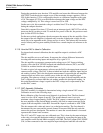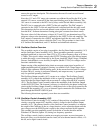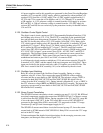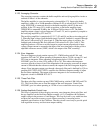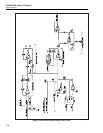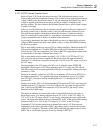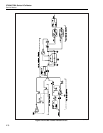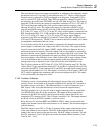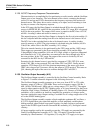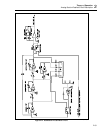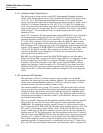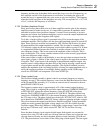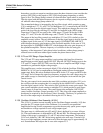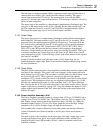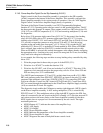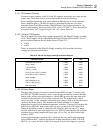
5700A/5720A Series II Calibrator
Service Manual
2-80
2-129. AC/DC Frequency Response Characterization
Characterization is accomplished by first performing an ac/dc transfer with the Oscillator
Output set to a low frequency. The ac/ac thermal sensor circuit, containing the thermal
sensor U16 and op amp U15D, characterizes the frequency response of the main ac/dc
thermal sensor. This sensor has no active circuitry at its input, and all switching is done
by relays to ensure a flat frequency response.
In the 20V range, the Oscillator Output is switched through R34 to the ac/ac thermal
sensor via SENSE HI, K5, and K9 in the set position. In the 2.2V range, R34 is bypassed
by K9 in the reset position. The output of this sensor is routed to the RCL line via U19C
and K6. A reading is taken and stored in memory as ACref.
The output frequency of the Oscillator Output is changed to the first cal point and the 15-
bit dac is adjusted until the reading from this ac/ac thermal sensor is the same as ACref.
The RCL line is then switched back to the ac/dc thermal sensor. A reading is taken
stored in memory as ACdif. The gain constant is calculated using the formula (ACdif +
Vdac)/Vdac, where Vdac is the DAC assembly (A11) voltage.
This ac/ac transfer function is also performed for the 220V range and the 1100V range.
These ranges are generated by the Power Amplifier assembly (A16) and the High
Voltage/High Current assemblies (A14 and A15). High voltage ac signals are attenuated
and connected to AC CAL, where they are connected to the sensor though relay K5 in
the reset position. In the 220V range, the output of the sensor is divided by Z4 and
connected to the RCL line by U19D and K6.
Protection for this thermal sensor is provided by comparator U22D, FET Q14, zener
diodes VR5, VR6, resistor network Z10, and diodes CR12 and CR13. During normal
operation, U22D keeps Q14 off. If the junction temperature of the sensor goes above
200ºC, the voltage at pin 3 increases, driving the output of U22D positive. This turns on
Q14, shunting the input of the sensor to common through CR12 and CR13.
2-130. Oscillator Output Assembly (A13)
The Oscillator Output assembly is controlled by the Oscillator Control assembly. Refer
to Figure 2-21 and the schematic diagram for the following discussion.
The Oscillator Output assembly generates an ac sine wave from 0.22V to 22V with a
frequency range of 10 Hz to 1.1999 MHz. There are five frequency ranges (100 Hz, 1
kHz, 10 kHz, 100 kHz and 1 MHz) and two voltage ranges (2.2V and 22V). The output
signal is either routed to the OUTPUT binding posts, or it is used internally by the Power
Amplifier, High Voltage, Wideband AC Module (Option -03), Current, or Switch Matrix
assemblies, or it is routed to an Auxiliary Amplifier for generation of voltages and/or
functions outside this range. Output sensing is available for all voltage ranges above 220
mV at the SENSE binding posts.
The Oscillator Output assembly contains a fixed-amplitude quadrature RC oscillator, a
0.22-22V digital/linear gain-controlled amplifier, a fixed-amplitude variable phase-
shifting network, phase-locked loop control circuitry for phase locking to an external
signal or the PLOCK signal from the Current/Hi-Res assembly (A7), and digital control
circuitry.
All power supplies used by this assembly except the -12S supply are generated by the
Guard Crossing/Regulator assembly (A17). The -12S supply is generated on this
assembly by a three-terminal -12V regulator (U2) using the -17S supply as its input.



